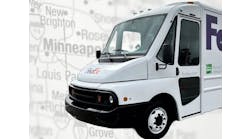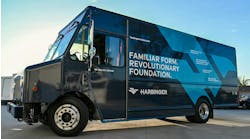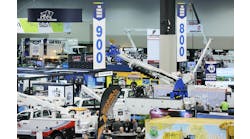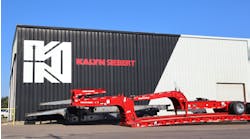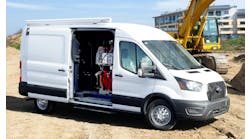Ford Motor Company plans to continue launching new chassis through the second quarter of next year, further expanding a commercial vehicle product lineup that it says outperformed forecasts last year, and continues to do so in 2019.
“For 2018 year-end, our Class 1-7 truck and van share was higher than our four closest competitors combined, (and) through the first half of this year, Ford’s commercial vehicle industry share in the Class 1-7 total is 46.4%, which was up two points,” said Eric Haglund, Ford’s specialty vehicle sales manager, who opened Ford’s product and technical resource update presentation at the 2019 Truck Product Conference.
Haglund said Ford is the only manufacturer with offerings in Class 1-7, and it’s launching more new and refreshed commercial vehicles than ever before in the company’s history, with nearly every vehicle receiving an update within 13 months.
Many of the product enhancements are derived from feedback received from advisory boards, Haglund said, noting that the inclusion of all-wheel drive in 2020 model-year Transit MCAs is based on fleet advisory input.
Before breaking down new offerings and updates in Ford’s medium-duty, e-series and stripped chassis models, company representatives said all commercial vehicles will be factory-equipped with modems as standard equipment, providing on-job connectivity for up to 10 devices through 4G LTE WiFi. Ford also will offer its new 7.3-liter gas engine, which pairs with the 6R140 heavy-duty automatic transmission, on all CVs.
Ford F-650 and F-750 medium-duty trucks are skipping 2020 model-year production and heading straight into 2021 production in January 2020, according to company officials. New MD safety features include traction control, hill-start assist and a class-exclusive electronic stability control system on hydraulic-brake vehicles.
New MD trucks also are receiving new electrical architecture, lower rolling resistance tires, dual alternator availability and upfitter interface module, among other features.
The big news for Ford’s e-series vehicles is there are no emissions-related frontal area restrictions with the new 7.3-liter gas engine. Like its MD trucks, e-series vehicles are skipping 2020 and entering 2021 model-year production in January with new standard safety features like electronic stability control, traction control and hill start assist; select Ford Co-Pilot 360 elements as optional equipment, including automatic emergency braking, lane departure warning, distance alert and driver monitoring; and an updated interior.
New e-series vehicles also boast new electrical architecture, including a 78-amp-hour battery, 210- and 240-amp alternators, a dual-alternator option and an upfitter interface module.
For stripped chassis vehicles like the F-59 Commercial Stripped Chassis, Ford is standardizing many new safety features, such as electronic stability control; and adding new electrical architecture and a fleet telematics modem, while commonizing brake systems across offerings in all gross vehicle weight ratings (GVWRs).
Stripped chassis step vans also are adding Co-Pilot 360 elements as optional equipment, including automatic emergency braking, lane departure warning, forward collision warning, distance alert and driver monitoring.
The 7.3-liter engine will be standard on 2020 F-450 and F-550 XL chassis cab trucks, Ford said, along with the TorqShift 10-speed automatic transmission. Diesels will have a PTO provision as standard. Driver assist technologies are available but not yet standard, as they won’t provide the same benefits as in other models.
The big news in the 2020 powertrain lineup, representatives maintained, is the introduction of the third-generation 6.7-liter Power Stroke diesel engine.
The F-600 is receiving a GVWR increase to 22,000 pounds, larger tires, upgraded brake rotors for improved cooling, larger u-joints on the drivetrain, upgraded clutch and new springs, including larger springs on the back. The vehicle will be certified as a medium heavy-duty vehicle, instead of a light HD, officials said.
Ford also is adding a 102-inch-wide rear wheel option and extended, wider mirrors for wider F-600 upfits. The company expects to debut the new wider wheels in early 2020.
For the Transit van, Ford is increasing the GVWR for the dual rear wheel chassis cab and cutaway to 11,000 pounds and introducing a 3.5-liter EcoBoost engine. The Transit also is receiving the same standard safety features as the other vehicles in its commercial lineup, along with new fuel economy features, new standard 10-speed transmission and new all-wheel drive system, which Ford deemed a segment “gamechanger.”
For dual rear wheels, Ford is adding a tire pressure monitoring system, optional driver assist technology like BLIS with trailer coverage, rear cross traffic alerts and enhanced active park. Interior updates include new seating options, like three-across fixed front seating that preserves cargo space for three-man crews, and new storage and charging points on top of the instrument panel.
Electrical updates include optional 400-watt invertor for vans, chassis cabs and cutaways, an upfitter interface module similar to the Super Duty’s, customer connection points on the outboard side of the driver’s-seat pedestal, standard 160-amp connection points and optional 180-amp connection points.
Ford’s updated body builder website, with the new fordbbas.com URL, includes new notes for hitch installation, the diesel fuel conditioning module location kit, maximum frontal area changes and FMVSS 111 rear vision requirements. Other Ford Body Builder Advisory Service enhancements include an updated look and feel, simplified menu navigation and mobile-friendly layouts for smart phones and tablets.


